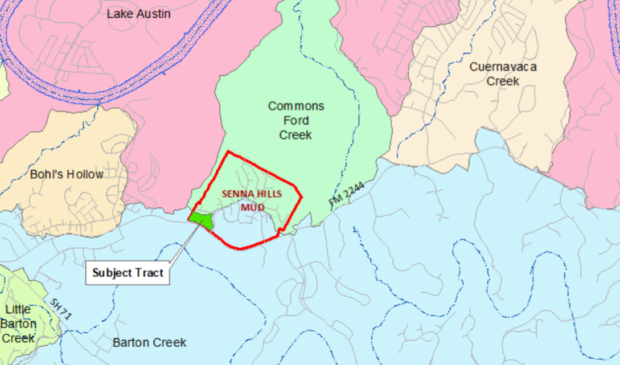Environmental Commission debates 30 years of history to approve project
Friday, January 18, 2019 by
Jessi Devenyns At the Environmental Commission, the third time was not the charm to recommend a change to the land plan of the Senna Hills Municipal Utility District. The proposed change would repurpose 11.73 acres of irrigation land with two developable acres allocated for a school into 11.73 developable acres of office space.
“It’s a deadlock,” Commissioner Wendy Gordon said after the third vote was taken. The commission voted twice to recommend the change and once to recommend denial of the change.
The two camps – for and against – were starkly divided on their reasoning and were unable to cross the aisle and find a compromise. On the approval side, commissioners Gordon, Andrew Creel, Curtis Smith and Brian Smith expressed their view that the entire 323-acre property was developed at a significantly lower density than originally planned, and so by not recommending this change to the land plan it was a breach of “good faith.” That sentiment was coupled with the fact that Gordon felt that the commission would approve the project if it came to them fresh and without 30 years of history attached, which swayed the vote for the four commissioners toward approval of the proposed project.
“The fact that the city doesn’t feel harmed by any of the developer’s actions to date is nothing short of a miracle,” said Creel.
On the other side of the aisle, an environmental argument was being made.
“We’re asked to make the environmentally best decision for this tract, and I don’t think anybody could possibly say that if we agree to more development that it is more environmentally sensitive,” said Commissioner Pam Thompson. She further argued that the deal the developer had made with the neighborhood to ensure its support by deeding the homeowners association 75 acres of irrigated open space leaves no room for guarantees for the city. She pointed out that at a later date the HOA could develop the land and the city would have no jurisdiction there.
Both arguments were based on differing interpretations of the contractual agreement on what to do with the irrigation land.
The language of the contract that staff and the commissioners were mired in read as follows: “… irrigation land may be utilized for recreational purposes and facilities which do not conflict with the use of said land for irrigation purposes. This restriction shall continue to be in effect following the time that irrigation may cease on said areas.”
Still, although the applicant and owner Rick Miller, and Steve Drenner of the Drenner Group, who was representing the applicant, acknowledged that the language was correct, they noted there was also 30 years of history and discussion surrounding the agreement and that it was never intended to be a static document.
Chris Herrington, the city’s environmental officer, confirmed that the contract had been amended in the past.
“The idea that we can’t ask for a land use change … is just wrong,” Drenner told the commission. “You would be imposing in this (extraterritorial jurisdiction) area a restriction that is absolutely not found in the city’s powers.”
City staff commented that they took no issue with changing the developable two-acre site usage from a school to office space. However, due to the contractual language, they were unable to support the request to make all 11.73 acres developable. “In the original plan, the restrictive covenant of the MUD … these lands would remain undeveloped in perpetuity. For forever,” said Atha Phillips, the environmental program coordinator at the Watershed Protection Department.
Drenner presented the commission with a proposed development that would develop slightly more than the two acres (3.28 acres total) and bring the impervious cover up to 28 percent. Current code allows for 20 percent impervious cover in the area of the Barton Springs Zone.
While the commission acknowledged that it was refreshing to have community support for the project and that they appreciated that up until this point the development was approached in a sustainable and lower-density manner, they could not move past the question of the contract language. Thompson called it a question for the courts and Chair Linda Guerrero said her decision came down to the “black and white” because “I don’t want to bank my decision on what happened 30 years ago, 20 years ago, or what happened in the bathroom six months ago.”
With their opinions firmly set, the commission was unable to pass a recommendation one way or another for the project. The question of whether to allow a change in the land plan for the Senna Hills Municipal Utility District will come before the Planning Commission next week. It is scheduled for a vote by Council on Feb. 7.
The Austin Monitor’s work is made possible by donations from the community. Though our reporting covers donors from time to time, we are careful to keep business and editorial efforts separate while maintaining transparency. A complete list of donors is available here, and our code of ethics is explained here.
You're a community leader
And we’re honored you look to us for serious, in-depth news. You know a strong community needs local and dedicated watchdog reporting. We’re here for you and that won’t change. Now will you take the powerful next step and support our nonprofit news organization?










